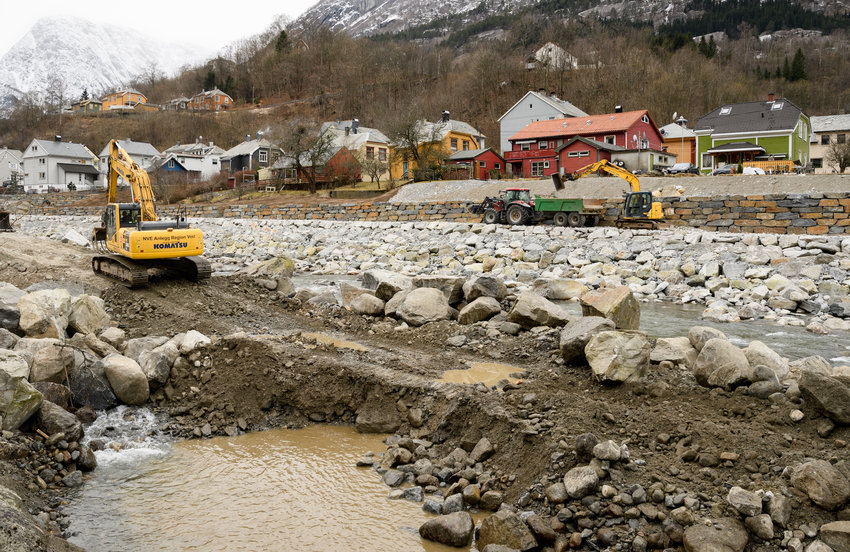The seasonal forecasts in Climate Futures can tell us about temperature, precipitation, and wind. In a new pilot project within the centre, we will use these variables to create an even more practical forecast for many of our partners, namely a frost forecast. This forecast will say something about how long it will be until the first frost comes in the fall, and how likely it is that it will come earlier or later than usual. Hopefully, the forecast will be a useful tool that makes it easier for fruit- and vegetable producers to decide when to start harvesting their crops.

Background
Many people in Climate Futures look at seasonal forecasts, and we want to increase the forecast time scale beyond what you can find on for example yr.no. Our partners Gartnerhallen and the Norwegian Computing Centre (NR) are now collaborating on a pilot project that will try to use these long-term forecasts to make a forecast for frost.
This pilot project is a part of the agricultural part of the node Sustainable Food Production. Fruit- and vegetable producers are indirectly involved in Climate Futures through partners like Gartnerhallen, and their feedback indicates that the seasonal forecast does not always provide them with the information they are interested in. A frost forecast that can say something about how early or late the first frost will come in the fall will potentially be able to partially cover the producers’ needs in a good way. In this pilot project, we try to make a model that can predict how long it will be until the first frost comes, and investigate how early we can predict it.
The seasons are quite short in Norway, so you want to make the most of them. A frost forecast like this one can therefore have a clear benefit for producers in Norway. A seasonal forecast cannot say anything about specific dates or exactly when the frost will start or end, but it can tell us about the likelihood of it happening. The forecast can tell us if the frost will come earlier or later than it has historically, and the producers can use this to plan the harvest compared to what they usually do.
About the pilot project
In this pilot project, statisticians at NR use an already existing statistical model in a new way. The model is widely used within medicine for something called lifetime analysis. Traditionally it has been used to look at the lifetime of patients, for example, given that they have received a certain medicine. Patients who have received the medicine are compared to those who have not. The model will then predict time until death, and we have used the same model to predict time until frost.
What is frost? In this pilot project, frost is defined as mean temperature below 0 degrees during the course of a whole day. However, this is not set in stone, and you can adjust the model to whatever the users are interested in. If a fruit producer thinks that only one hour of -1 degrees can damage the fruit tree, we can adjust the model after this and still use it in the same way.
In this collaboration, Gartnerhallen provides input on which variables are most interesting for the producers, and then NR uses this information to develop a model that can be used to create a frost forecast.
Climate Futures uses seasonal forecasts that are produced from several weather centres in different countries. A seasonal forecast for temperature is a long-term forecast ranging from 0 days to about 5 months ahead, which looks at how the temperature develops. We get around 100 scenarios for this development day by day in the relevant time period. This temperature forecast is translated by the statisticians at NR to a frost forecast using the above-mentioned model for lifetime analysis.
Given that the temperature forecast is a global forecast, it needs to be adjusted to be better suited for places in Norway. After these adjustments, you use all the 100 scenarios as input in the lifetime analysis model, which then gives a probability distribution for when the frost comes, or how long it will be until the frost comes. For instance, if you have a forecast that starts 1 October, you calculate the number of days from 1 October to the first frost after 1 October. Additionally, you can adjust the model to predict when the frost will end instead of when it starts. This will help producers know when it is safe to plant in the spring.
The weather forecasters abroad make the forecast for example 1 October for 1 October and about 5 months ahead. A practical problem we have at the moment is that they do not publish the forecast until 10 days after it is made. This is probably fine for some areas of use, but for a frost forecast it can be a problem that we do not get the forecast earlier because when we get it on 10 October, the forecast is already a bit “old”. Thus, there are some practical issues connected to distributing the forecast to the end-users.
Results and the road ahead
The first part of the pilot project was mainly academic to see if the methods work. It turns out that it is possible to get quite good results from the seasonal forecast for the period 1-4 weeks from the forecast is issued. Furthermore, the task will be to solve the practical problems and to actually get the forecast out to the users, which is an important part of the project.
The next step in order to achieve this is to download monthly forecasts, which are published two times a week for 6 weeks ahead and combine them with the seasonal forecasts that are published once a month. We expect to gain better insight by combining the two types of forecasts. The actual observed temperature will also be used in the project. For example, for the forecast from 1-10 October that is published around 10 October, we can look at what actually happened between 1 and 10 October and investigate how accurate the forecast was for this period. You can then see which scenarios you trust more, and which have already become unlikely. A priority in the project now is to operationalise and distribute the forecast to the end-users. Exactly how that will happen in practice is still a bit unclear.
In this pilot project, we look at the forecast in a slightly different way compared to what we typically do. Normally, we look at how the temperature develops day by day, but here we look at the time until a specific event – time until the frost starts or ends. This is a framework that is under development in Climate Futures and will be used in several projects. One example is a project that looks at time until specific meteorological events in the atmosphere, in collaboration with the Renewable Energy node. For now, these projects all go under the umbrella “Time to Stuff”. Developing new methods to reduce climate risk is also an important goal for Climate Futures, and it is very exciting when several sectors can make use of the same method for different purposes.
Partners involved:
Norsk Regnesentral (NR) does research within statistical modelling, machine learning, and ICT. NR has one of Europe’s biggest research communities within statistics, and works within several sectors, including climate and environment.
Gartnerhallen is the biggest distributor of Norwegian fruit, berries, vegetables, and potatoes in Norway. More than 1000 producers across the whole country own the company together and deliver their products through Gartnerhallen.

